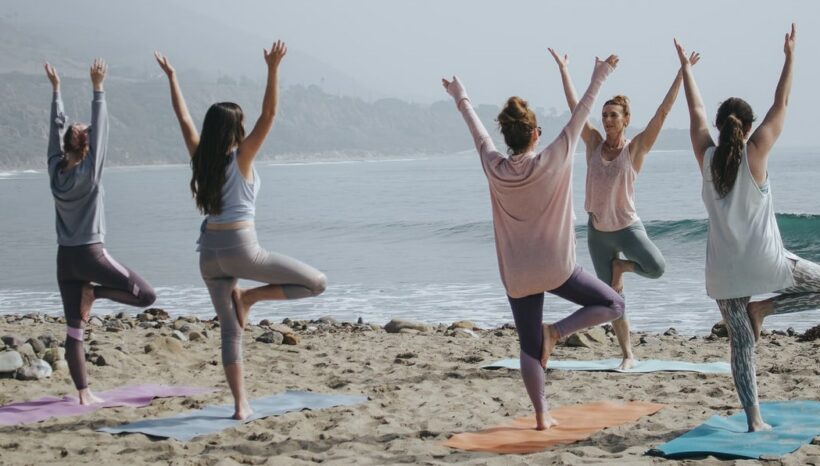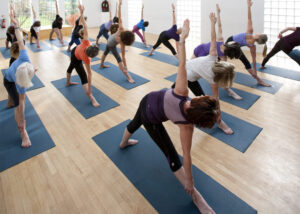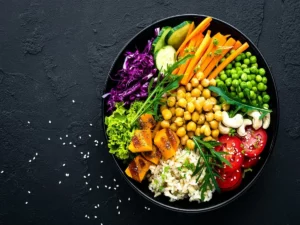Founded in India thousands of years ago, yoga is now a world-spread craze. It is a practice that emphasizes the connection of mind, body, and spirit. It has one final goal – reaching enlightenment and becoming one with God.
Today, there are many types of yoga, but the most popular ones are Hatha, Ashtanga, Vinyasa, Kundalini, Jivamukti, Yin, Power, Bikram, Iyengar and Kripalu yoga. Although they all have their specific features, the benefits are similar. Physical and mental benefits of yoga are now researched by science and proven by thousands of devoted practitioners worldwide.
- Increased flexibility
- Increased strength and muscle tone
- Improved cardio and heart health
- Better sleep
- Decreased anxiety and stress
- Reduced injuries and chronic pain
- Inner peace
These and many more benefits come with each type of yoga, however, the focus is different. Some classes, such as Ashtanga, Power, and Vinyasa yoga accentuate vigorous movements and advanced postures. They are focused on increased strength, breath awareness, and cardio health. Others, including Yin, Kundalini and Jivamukti yoga have slower and gentler sequences, and more focus on spirituality and energy. They help you to become more flexible and reduce stress and anxiety.
There is no single “best yoga type”. That will depend on your individual goals and needs. Once you know what you strive to achieve with your yoga practice, go through our list and find which of these types of yoga is the most suitable for you.
10 Most Popular Types Of Yoga
Hatha Yoga
The first yogis considered asanas to be just one of the limbs of yoga one needs to master in order to achieve enlightenment. At the time, Hatha Yoga was a general term that encompassed all types of physical yoga. However, in the modern age, this has changed. Yoga teachers are now offering specific hatha yoga classes, including Hatha restorative yoga and Hatha Vinyasa yoga.
Since there is no single definition of what the word means today, it can be hard to know what to expect when you go to one of these classes. However, it is generally accepted that Hatha style yoga describes a gentle and slow class. Breathing (pranayama) is the main focus and the poses are held longer than in other classes. The choice of asanas is appropriate for beginners. Hatha Vinyasa yoga sequences are more dynamic and challenging, but still considered low impact yoga when compared to say, Ashtanga or Power Vinyasa. On the other hand, Hatha restorative yoga is designed for older practitioners and those with injuries.
Ashtanga Yoga
Literally translated to “Eight Limbs Path”, Ashtanga yoga is one of the most widely spread types of yoga. It was popularized in the west at the beginning of the 20th century by Sri K. Pattabhi Jois but is traditionally practiced in India for hundreds of years. Ashtanga yoga is divided into six series, each more challenging than the previous. All Ashtanga yoga series begin with 10 sun salutations, followed by standing and sitting postures.
This style of yoga is usually recommended only to advanced practitioners. However, you can learn Ashtanga yoga basics through online videos or an introductory class commonly called half-primary series. Breath is in the core of every Ashtanga class, and the sequence is guided with basic verbal instructions. Ashtanga Mysore is a variation of the style that allows the practitioners to practice at their own pace. Ashtanga yoga is traditionally practiced every day and takes years to master it in its highest stage. This is one of the reasons why Ashtanga is generally considered as a lifestyle, that includes incorporating the core yoga beliefs in all aspects of your life.
Kundalini Yoga
Also known as the ‘Yoga of awareness”, Kundalini yoga is a meditative practice that focuses on energy as much as asanas. The practitioners emerge into an array of exercises, including postures, meditation, mantras, and breath practice. The movements in a Kundalini yoga class are called kriyas. They are often repetitive and follow the breath with a goal to draw the energy at the spine up through all seven chakras. This may sound abstract to beginners, however, the classes are adapted to every individual.
Kundalini was brought to the West in the 1960s and is considered to be one of the rare types of yoga that preserved the authentic practice from India. Overall, Kundalini meditation and yoga are a perfect practice for those who want to focus on their awareness more than solely improving their physical composition and health.
Power Yoga
Power yoga is a challenging, fitness-based yoga designed to increase one’s strength, flexibility, and endurance. Although it is one of the newer yoga styles, it was modeled after the traditional Ashtanga practice. A Power yoga class is vigorous, and the teachers have the freedom to design the sequences on their own. For this reason, each class is different. Some teachers even include weights and western exercises such as push-ups and crunches. There are no specific power yoga poses, but there are many variations to the traditional asanas.
The classes are dynamic and include repetitive motions and long holds. Power is an ideal yoga style for those who want to focus on the physical benefits of yoga. Today, countless yoga teachers are offering Power yoga free online classes which makes this practice available to everyone, resulting in its risen popularity. Some believe this type of yoga is not authentic, but that depends only on the practitioner and his intentions. If you practice with spirit and breath awareness, then Power yoga can be just as transformative as any other style.
Vinyasa Yoga
Vinyasa Yoga was created from Ashtanga in 1980 and is one of the most dynamic types of yoga. The class consists of various postures that are practiced in a continuous flow. Vinyasa yoga class can refer to a number of different styles, such as Ashtanga and Hatha Vinyasa yoga.
In general, Vinyasa yoga practice begins with sun salutations. Other postures and flows are then added, with the same focus on the breath and constant motion. The practices will vary depending on the teacher, but they will all improve your strength and cardio. Vinyasa style yoga is commonly seen as the best yoga type for weight loss. Nevertheless, the unity of mind, body, and spirit should still be seen as its main purpose. That’s why many teachers incorporate longer holds and meditation at the end of the practice.
Bikram Yoga
Named after its founder Bikram Choudhury, Bikram yoga is a unique type of yoga that requires specific conditions. Also known as Hot yoga and Steaming yoga, Bikram is practiced in a room heated to 105°F that should ideally have 40% humidity. This allows the body to sweat, resulting in enhanced weight loss and detox.
The Bikram yoga class consists of 26 poses and two breathing techniques. These postures are practiced twice in a 90-minute time frame. If you would like to try out this yoga style, you would need to find a Hot yoga studio because the specific conditions don’t allow the usual “all-around” studios to hold these classes. Since it’s very challenging, this type of yoga is not the best choice for beginners. Intermediate practitioners should also practice with caution and drink plenty of water to avoid dehydration.
Iyengar Yoga
Founded by the Indian guru B.K.S. Iyengar, Iyengar Yoga puts proper alignment above everything else. The postures and sequences are similar to those in Ashtanga but are practiced at a much slower pace. This allows for small alignment changes with a goal to get the most out of each pose. Another thing stands out in Iyengar yoga is the frequent use of props such as bolsters, belts and yoga blocks. They help beginners and those with structural imbalances to practice the asanas properly, while also accommodating injured practitioners.
Iyengar Yoga is slow but still challenging. If you practice regularly, it will improve your stability, mobility, and strength. It is a very relaxing yoga style, perfect for those who enjoy a methodical approach to yoga. If you don’t have a Iyengar yoga class nearby, then Iyengar’s renowned book “Light on yoga” would be an excellent first step.
Kripalu Yoga
Similarly to Kundalini yoga, Kripalu yoga places equal focus on mind, body, and spirit. The practice is similar to Hatha Yoga with a big emphasis on meditation and physical healing. It is welcoming to beginners, and adaptable to people of all ages, sizes, and conditions. Once you start practicing regularly, you will also learn to take the awareness away from the yoga mat into your everyday life.
This transformative practice instructs students to listen to their body and adapt the poses towards their individual needs. Each body is different, and in Kripalu, you can adjust the sequence in order to feel the most benefit from it. The classes usually start with pranayamas, continue with asana sequences and end with Shavasana, or final relaxation. Kripalu yoga will teach you to cherish your body and nourish compassion and love in every aspect of your life.
Jivamukti Yoga
Jivamukti Yoga is a modern style founded in 1984. In its core, it’s a Vinyasa-style practice with an emphasis on Hindu philosophic teachings. Like with all types of yoga, Jivamukti’s final goal is enlightenment. This goal is reached through five tenets, which are ahimsa (nonviolence), bhakti (self-realization), dhyana (meditation), nada (deep listening), and shastra (yogic teachings.)
The typical Jivamukti yoga class consists of physical movements, Sanskrit chanting, pranayamas and ends with a lesson. One of the ideals is a connection with the Earth, so the most devoted practitioners are following a nonviolent, vegetarian lifestyle. Jivamukti is a great blend of mind and body practices and ideal for those who want to incorporate the ancient yogic teachings in their daily lives.
Yin Yoga
Yin Yoga is a meditative practice that focuses on lengthening connective tissues and improving flexibility. It wasn’t created as a standalone practice, rather complements Yang Yoga. While Yang Yoga is active and dynamic, Yin is passive and leaves most work to gravity. There is no warm up, and the sequences are built with basic poses, usually on the floor.
The postures are held for five minutes or more and should be done with completely relaxed muscles. Once you find your sweet spot, you should try to stay in a pose with minimal movement. Props, such as blankets, pillows, and bolsters are commonly used to allow deeper relaxation. The long holds can be uncomfortable after some time but you should never feel pain. Yin Yoga complements all styles on this list and will teach you to let go and find inner peace.
What Types Of Yoga Are Best For You?
Now that you are aware of the major types of yoga available today, you probably started thinking about which one to choose as your main practice. Although following a single practice does have its benefits, the real truth is that you don’t have to make a definite decision. Most yogis believe you should try various styles, and continue practicing those that are most suited to your needs and goals.
Kundalini, Hatha and Yin Yoga are ideal practices for those who want to improve their flexibility and reduce frustration and stress. Ashtanga, Vinyasa and Power yoga, on the other hand, will help you strengthen and tone your body, while also teaching you to move along with your breath. All types of yoga combine the same postures that have been developed over thousands of years, they are simply organized in different manners. Hence, if you practice with awareness and listen to your body, each of them will help you to connect with yourself and others, and get one step closer to enlightenment.







